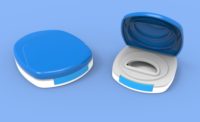Market Trends: Pharmaceutical packaging
Digging deep into pharmaceutical safety
Ensuring pharmaceutical safety goes beyond the supply chain.


The HCPC’s Prescription Packaging In-Use Stability Study brings to light possible adverse effects daily exposure to moisture and oxygen can have on non-coated tablets stored in traditional amber pharmacy vials, plastic bottles and low-barrier blister films.

Pharmaceutical products, such as Simvastatin shown, undergo significant change in disintegration time when not packed in a barrier blister in all the conditions studied.



Lately, the phrase pharmaceutical safety conjures up images of 2D bar codes, discussions of serialization and pedigree, 10 years of rolling implementation of the Federal Drug Quality and Security Act (DQSA) but pharmaceutical safety means something much more basic and, sadly, long overlooked.
Pharmaceutical safety certainly includes safe transit from the point of manufacture to the pharmacy which sums up DQSA but, it also includes safe delivery to the patient, safe use by the patient and safe keeping of the drug to ensure efficacy is maintained.
We could argue the merits of safe delivery through the pharmacy but based upon strong evidence to the contrary DQSA will need to be modified someday to address this process. I think the battle with 50 state boards of pharmacy was too much for Congress and DQSA stopped short. Maybe 10 years down the road when DQSA is fully implemented and we still see counterfeits showing up they will realize that they left the door open in pharmacy. Maybe.
Let’s look at a problem much older than the ones addressed by DQSA, one that we actually have the ability to solve with or without Congressional intervention. I’m talking about product stability through the life cycle of the drug. “What’s the problem with product stability?” you might ask. Manufacturers package and test containers according to FDA guidelines. They test containers for product stability according to ICH guidelines. We’ve been delivering drugs to pharmacy in bulk containers for more than 60 years so they can be transferred into amber vials by pharmacists tediously counting by fives to allow safe delivery to and consumption by patients. What could be wrong with this system?
For starters, the package that comes in the back door of the pharmacy was tested in a static environment meaning that we test unopened containers. Manufacturer containers quite often include a desiccant for moisture absorption or possibly an oxygen scavenger. This closed environment provides a great home for products — until they reach the pharmacy.
Once the dispensing process begins at the pharmacy this container will be repeatedly opened, product dumped out, thirty, sixty or ninety counted and then the original container is resealed with fresh moisture and oxygen in place. This process is repeated until the entire product is dispensed. How many times does the original container get opened? Well, a 500 count container servicing 30 count containers will be opened 16 and 2/3 times. How long will this take? For a fast moving product it could be a few days, for a slow moving product it could be easily more than a month. Once in the vial the product continues to see environmental exposure for the duration of the prescription.
What is the impact of all those openings and refreshing the container environment on the remaining products? No one seems to know as far as I can determine. We do know that the conventional amber vial is a one size fits all (or protects all) container used for products regardless of their protection needs. We also know that products dispensed in vials are granted one year dating without pharmacy providing evidence that the particular drug is safe in that container for that time with multiple openings in the cycle. There are thousands of different drugs in the market, all seemingly well protected by the same amber vial. A magic container or a lack of attention to detail?
A recent study by the Healthcare Compliance Packaging Council (hcpconline.org) seems to indicate it may be the latter. The study was designed to compare how common chronic condition drugs (Simvastatin for high cholesterol, Lisinopril for high blood pressure/hypertension and Metformin for Type 2 Diabetes), fared during 30, 60 and 90 day prescription cycles when using different package forms, specifically, polypropylene vials, high-density polyethylene (HDPE) bottles and polyvinyl chloride (PVC) blisters, and high-barrier PVC/Aclar® or PVC/polyvinylidene chloride (PVdC) blisters. The study looked at changes in physical characteristics which are measured according to ICH guidelines, specifically moisture gain, hardness change and disintegration time. The study also looked at multiple environmental conditions to simulate typical home environments these products may encounter.
The outcome of the study was clear. When products are repeatedly exposed to typical home environments during normal prescription cycles their physical characteristics are impacted significantly. Our time tested pharmacy packaging solutions have not been protecting products in the manner patients should expect and industry should demand. The industry has been tasked with securing the supply chain while the most fundamental part of our system remains unsafe. Even the low barrier PVC blisters did not provide adequate protection.
And consider this: if we begin packaging products in high barrier blisters, serialized blisters to meet the intent of DQSA then we hinder the opportunity for introduction of counterfeit, gray market and diverted drugs to reach patients. We also reduce the likelihood of pharmacists dispensing returned or outdated drugs. All of the events alluded to here are well documented and will continue to occur under DQSA if we continue to allow pharmacy repackaging of drugs.
So in the solution of protecting drugs from the environment through the prescription cycle we also see the chance to close a gap in DQSA and truly improve the safety of the supply chain. In order to have a successful supply chain, products need to be safe through the entire process including consumption by the patient. When any one segment fails the entire process fails.
The Healthcare Compliance Packaging Council holds a yearly competition honoring noteworthy compliance-prompting/patient adherence packages. The winning packages from the most recent competition include:
- 2014 HCPC Compliance Package of the Year: Astra Zeneca SEROQUEL XR® 14-Day Sample Kit from MWV
- 2014 HCPC Compliance Package of the Year First Runner Up: Eli Lilly Strattera® Physician Sample Pack from PCI
- 2014 HCPC Compliance Package of the Year Second Runner Up: Novartis® Exforge HCT® from PCI
Looking for a reprint of this article?
From high-res PDFs to custom plaques, order your copy today!









